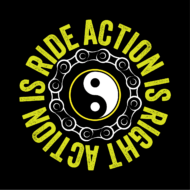
I was thinking today how pedaling technique = meditation.
For some more recreational cyclists this may or not make a lot of sense. I realize to some extent that makes me sound bike-snobby, it is what it is. If you’ve never tried to ride tempo for any specific length of time or if you don’t really know what tempo means with relation to cycling, it might not land right. Or maybe it clears it all up for you. Fuck if I know.
People sometimes ask me why some cyclists like to be physically attached – clipped in – to their pedals. It’s about efficiency. When you’re clipped in, you can push the pedal as well as pull (on the up-stroke) on the pedal. You can accomplish the same technique even if not clipped-in if you’re aware of what you’re doing with your feet, but the experience is much more profound when you’re attached the pedals.
The goal is to create a condition wherein your forces on the pedals work in a circle. You’re pushing down and pulling back and up and then forward and down again. With each foot. The ideal is you are spinning and the force exerted in each direction is the same, consistent. This is peak efficiency. You are doing the maximum work without putting yourself into the Red, getting maximum torque, 100% of your 360º pedal stroke. With both feet. At the same time.
The alternative is ‘mashing’ or ‘pedaling squares’ wherein you’re only pushing down on the pedals and letting them spin back up by themselves, or only pushing down and pulling up and not forward or back or any combination in-between. It’s not smooth. It’s clunky. And if you ride bikes a lot you know it.
There are times on any ride – and sometimes not at all – when you find a few moments of perfect spin. The idea being to be working at about 80% of your maximum effort, factoring in the road surface, incline, how many coffees in you are that day, and how close the demons are on your heels. I find these moments are most often on long, straight, flats – either slight incline or decline, but really they can happen whenever if the Universe swings in your favour.
When you get the pedal stroke(s) right, the effort sort of disappears. In the trade we say, ‘it felt like there was no chain on the bike’. You’re spinning at your max attainable effort, and because your form is bang on, you are your most efficient, and you’re doing just enough work to keep an object in motion and it wants to stay in motion. It’s like you are simply moving through time and space by will alone and you could go on in this state for any distance indefinitely. I guess it’s like you are motion.
This – at least to me – is what I’ve always understood tempo to be. You feel it coming on…then….there…that’s it…aaaand we’re floating…..- then you hit a bump and – shit. It’s gone. Your pedal stroke is garbage again.
So you begin again trying to find the spin.
Repeat. 1,000 times each ride. Trying to find a few moments of float, and make them last longer each time.
If I had to explain meditation to someone who’s never done it, that’s a pretty good metaphor.
You’re sitting and trying to find a moment of stillness and quiet in your mind. You’re conscious of your form. You’re quieting the noise in your head, thoughts are dropping away – but some are still nagging. Some demons are still yammering. After 15 minutes and forty-seven seconds of staring at a blank wall, arguing with yourself, ruminating, trying to ignore the tick, tick, ticking noise that the air exchanger has been making since you started, you feel it coming on…then…it’s almost there…quiet and almost perfect stillness…this is it! This might be it! Is this it? I THINK THIS IS IT.
DON’T FORGET TO GET MILK WHEN YOU PICKUP THE KID THIS AFTERNOON.
And you’re pedaling squares again.
And you begin again.
And yes, it’s 100% as frustrating as it sounds.
I’ve read experienced meditators tend to find the space easier – it would make sense, they have thousands of hours into the effort. Pro cyclists – same. Hence, tempo for days.
For us mere mortals it’s more a work in progress.
Many hours. For elusive moments of grace. That is the practice. In both cases.
